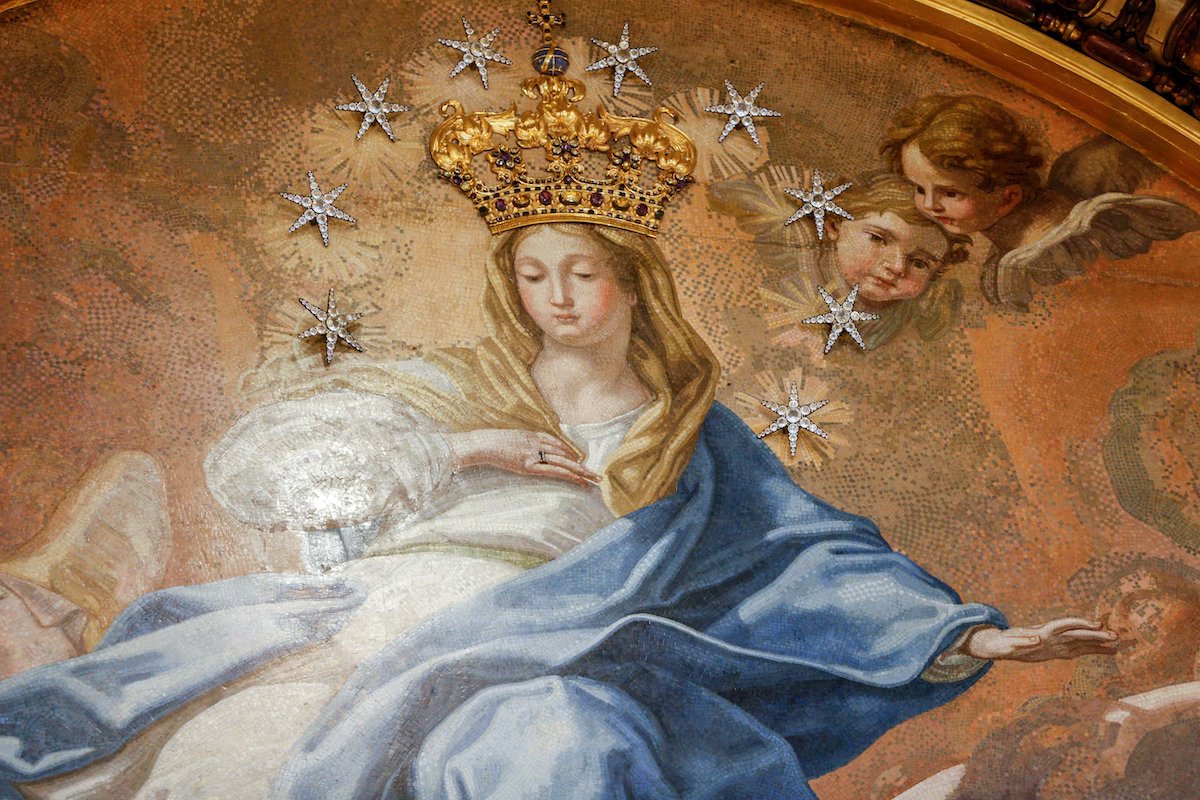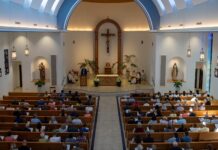By Justin McLellan, Catholic News Service
VATICAN CITY (CNS) — Of the more than 1,300 Marian images crowned around the world, one of the first to receive this honor does not have a crown today.
For over 350 years, Michelangelo’s Pietà, instantly recognizable by Catholics and non-Catholics alike, was one of several “crowned Madonnas” in St. Peter’s Basilica. Until 1924, the disproportionately large Mary bore a golden crown supported by two angels, and over the head of the limp Jesus in her lap was a halo. Coronated in 1568, the sculpture was at the beginning of a wave of Marian coronations which took off in the 17th-century.
“In the early 1600s, a Capuchin friar had the nice idea of officially coronating the Marian images that had a certain devotion, and so he went around towns and began this practice,” said Pietro Zander, curator of a Vatican exhibit on Marian coronations, during a tour of the Marian imagery in St. Peter’s Basilica May 30.
In 1636, the Vatican began supporting, and regulating, Marian coronations. The local community, typically a church or Marian shrine, was required to write to the Vatican confirming that the image was of “continuous and ancient devotion, used for religious purposes and generated an increase in Marian devotion,” said Zander.
Once the image was crowned, the community was obliged to send a letter to the Vatican guaranteeing that the act of coronation followed the prescribed rules along with a painting of the coronated image.
“These images started arriving — these paintings, since there wasn’t photography at the time –are beautiful since they were commissioned by artists,” said Zander. The paintings acted as a type of postcard meant to share each community’s particular Marian devotion with the Vatican. Often, text at the bottom of the painting explained the community’s devotion and told of the coronation event.
Hundreds are still preserved in the Vatican and, beginning on the feast of the Visitation of Mary May 31, 15 of them from throughout Italy will be on display in St. Peter’s Basilica. The exhibit, titled “Crowned Madonnas,” is organized by the Fabbrica di San Pietro, the office responsible for maintaining St. Peter’s Basilica.
Each image comes from a different region in Italy and is accompanied by the story of a community’s source of devotion. One image, called “Our Lady of the Stone,” shows Mary with a wound on her right arm which is said to have begun bleeding after a drunken soldier threw a small rock at it. Another tells of monks finding a worn and discolored statue of Mary that miraculously returned to its original form and color during Mass and brought the withered flowers nearby back to life.
Zander said the exhibit, which runs until Oct. 7, adds to the rich history of Marian devotion already present in the pope’s basilica. He recalled that the first image brought into today’s St. Peter’s Basilica was a 12th-century fresco of Our Lady of Perpetual Help taken from the wall of the old basilica that once stood in its place.
Additionally, the image of “Mater Ecclesiae” (Mother of the Church) in the Chapel of Our Lady of the Column is taken from a piece of a column that stood in front of the old St. Peter’s Basilica. Zander explained that that after the assassination attempt on St. John Paul II in 1981, the pope requested that an enlarged image of “Mater Ecclesiae” be placed above a window of the Apostolic Palace over the colonnade in St. Peter’s Square to welcome visitors. The last Marian image to be crowned in the Vatican was Our Lady of Czestochowa, widely venerated in Poland and by the Polish pope, just hours before his death in 2005.
While the current exhibition shows Marian paintings from all of Italy, Zander said he hopes the basilica will rotate through its collection of “crowned Madonnas” to give a glimpse of how the mother of Jesus is venerated around the world.







